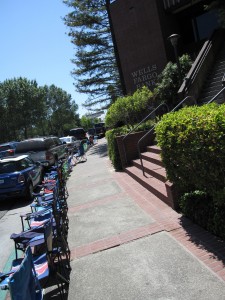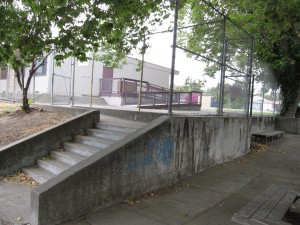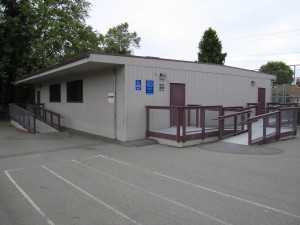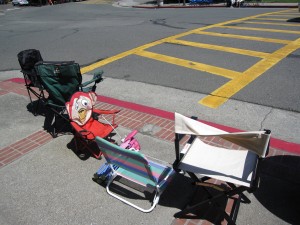It is time, according to the City Charter, to reorganize Piedmont Unified School Board officers. On July 11, at 7:00 p.m., the Board will meet in the City Council Chambers to vote on a new President and Vice President. Roy Tolles, current President, will have completed his term. Vice President Rick Raushenbush is expected to be elected President, and Andrea Swenson, a new Board member, to be elected Vice President. Presumably, Superintendent Constance Hubbard will be chosen to continue as Secretary of the Board. Board committee and liaison assignments will be accepted at the meeting.

Piedmont’s Public Safety Committee will meet on Thursday July 12, 2011, at 5:30 p.m. in the City Council Chambers to discuss ways to encourage residents to hold neighborhood safety meetings for presentations by public safety personnel. A map showing where the meetings have already been held is available. Also, the Committee will discuss disaster preparedness for the City and the Schools.
All meetings of the Public Safety Committee are open to the public and include an opportunity to address the Committee with concerns or ideas.
On Tuesday, July 3, the Oakland City Council (OCC) approved a five-year $150,000 lease and $200,000 for moving costs and tenant improvements to relocate the Piedmont Avenue Branch of the Oakland Public Library to a modular unit on Echo Avenue.
The Oakland Public Library (OPL) administrators have been in negotiation with the Oakland Unified School District (OUSD) for several years about moving the library to the grounds of the Piedmont Avenue Elementary School at 4314 Piedmont Avenue. The used modular unit has been an OUSD classroom for some years and, according to the contract, is leased to the City in “as-is condition. …City acknowledges that neither District nor District’s agents have made any representation or warranty as to the suitability of the Modular Building…” The modular unit is approximately 1600 square feet (compared with the current 1700 square foot library building) and is located four and a half blocks from the current library location.
The modular unit will be rented for $2500 per month or $30,000 per year – $150,000 for the term of the five-year lease agreement. According to the lease contract, it commences as of “February 1, 2012 or when the modular has been delivered to the City.” Utility expenses will be estimated by the OUSD and paid by the City of Oakland. The terms of this agreement with the OUSD were recommended for approval by OPL staff. On June 26, the Life Enrichment Committee of the OCC also recommended the proposed agreement and tenant improvements funding.
The rent will be paid from Measure Q fund 2241, the Oakland library parcel tax approved by 77.2% of voters in Oakland. The $200,000 for the cost of the move and tenant improvements to the modular unit will come from Library Trust Fund 7540.
The Piedmont Avenue branch library has been the original and only tenant in the architect-designed library building since 1932. When Citibank offered to sell the library building to the City of Oakland in 2008 and 2009, Oakland declined. Citibank then required the private purchaser of the adjacent bank building to buy the library building and library building lot as a condition of the purchase of the bank building and its lot. For an entire year the new owner privately subsidized the library by providing it with free rent. When the City remained uninterested in buying the library building, the new owner offered a 10-year lease at $4250 per month. The City declined this offer as well, but in the fall of 2010 entered into a one-year lease with a one-year optional extension. When the first year of the lease expired, the City declined to exercise the extension. In order to have more flexibility, the City preferred a month-to-month tenancy with a 30-day intention to vacate notice provision and a monthly rent of $4900. It is expected that the 30-day notice will be given by the City Administrator this summer.
Three libraries in the OPL System are not City-owned: the Cesar Chavez Branch Library in the Fruitvale BART transit village, the Eastmont Branch Library in Eastmont Mall, and the Piedmont Avenue Branch Library at 160 41st Street with convenient parking across the street in the Key Route Parking Lot. The move into the modular unit is viewed as a temporary situation, lasting at most five years, until a permanent library facility can be planned and financed.
Opportunities Abound for Greater Community Use of KCOM
A year and a half ago, I wrote an opinion piece for the Piedmont Civic Association (PCA) about the viability of KCOM, Piedmont’s community television station; could it and should it be revived to its former relevance: http://www.piedmontcivic.org/
2011/02/09/opinion-should- kcom-be-revived/ Briefly, the piece outlined the origin of KCOM, which began in 1984 when Piedmont had two cable stations: a government station and an educational station. The Chief of Police managed the government station, which included supplying city news and safety updates, and a teacher in the High School managed the Piedmont Unified School District’s station, which included filming sports, student generated programs and performances. After a few years, the School District station closed, because it took too much additional time for one teacher to supply content for a TV channel AND teach. Likewise, the city’s station was turned over to a professional film producer and volunteer, Polly Rich. Polly not only anointed ‘KCOM’ its acronym (the ‘com’ is for community), but she got the station up and running with a Board to oversee the station’s mission and yearly goals including fund-raising drives, and built an energetic volunteer base to produce local content. After awhile, Polly found that she too was putting in 40+ hour weeks and requested a stipend. Piedmont’s new City Administrator, Geoff Grote, appointed city employee, Marietta Blessent, to then oversee the station. > Click to read more…
Chairs Herald Piedmont’s Fourth of July Parade.
Since the last day of June, Highland Avenue has been lined with chairs of every sort and description. Chairs cover crosswalks and even a bus stop, as eager parade watchers place their chairs in the public right of way for front row seating. Some residents along Highland Avenue host a parade party.
Piedmont’s annual Fourth of July parade will flow down Highland Avenue from Park Way Avenue starting at 11:00 a.m.. Neighborhoods, musicians, antique cars, and organizations participate along with a yearly favorite, Piedmont’s own volunteer marching band. The parade terminates at the Main Park near the Excedra followed by music, food, and picnics in the park.
 This photo shows chairs placed days before the parade in front of Wells Fargo Bank.
This photo shows chairs placed days before the parade in front of Wells Fargo Bank.
PERS Contract, Sewer Rehabilitation Project, Tax Renewal, Ballot Arguments, KCOM Funding
The City Council on Monday, July 2, 2012, will continue to consider in closed session pending litigation in the matter of Friends of Moraga Canyon v. City of Piedmont and potential litigation on Blair Park.
At the 7:30 p.m. meeting the Council will begin the official process to place the renewal of the City parcel tax on the November 6, 2012 ballot. The required proposed ordinance is essentially the same as the current tax and provides for 4 years of taxation between 2013 and 2017 with Council approval an annual increase up to 4% based on inflation criteria. If approved by 2/3rds of those voting on the measure, funds would go toward City services. This year the current parcel tax generated approximately $1,550,000. It expires on June 30, 2013.
The Council will also consider procedures for an argument supporting the parcel tax measure and any rebuttal to an argument filed against the parcel tax renewal. The failed February 2012 Sewer Surcharge Tax argument drew questions regarding participation by a majority of the Council outside of the public process.
KCOM funding will be changed in the future according to State legislation. The Council will consider an ordinance on video franchising.
A revised CalPERS (California Public Employee Retirement System) contract for miscellaneous employees will be considered. The revision reduces retirement compensation for new employees from 3% at age 60 based on their highest year of compensation to 2% at age 60 based on the average of their three highest years of compensation. This change has been approved by the bargaining unit and the City Council.
The City will rehabilitate the High School and Middle School sanitary sewer mains. To accomplish this, the staff proposes an agreement with J. Howard Engineering, Inc. in the amount of $65,960. The construction budget for the project is set at $103,470.
Other agenda items include: Community Development Block Grant for disabled access to Beach recreational facilities, Alameda Clean Water Program participation with a 15 year term, and a contract with Coastland Engineers to become Piedmont’s City Engineer, per the City Charter.
View the full agenda and staff reports here.
New Vision for Piedmont’s Blair Park-
Recently, there have been many suggestions for Blair Park in the local media. Some credible and some ridiculous. If one thing is for sure, it is time for a “New Vision” to emerge for Piedmont’s Blair Park. This should be a plan that is modest in scope, has a cost that is appropriate in the context of Piedmont City budget priorities, and involves extensive public participation through a transparent process.
Any new plan should consider the current status of Blair Park. The considerations for a development plan can be summarized as follows:
Arterial Robustness and Safety
Moraga Avenue is a critical traffic artery, but has vulnerabilities, particularly under stressed circumstances. Any development should at least maintain the arterial aspect of the avenue, and more desirably, enhance it.
Moraga Avenue in its present condition has safety issues related to uphill bicycle traffic and the use of the few parking spaces that exist. An improvement in both these safety areas is desirable, and the need for such improvements, by themselves, provides motivation for limited development solutions.
Moraga Avenue is also dangerous for any pedestrian attempting a crossing. Development plans should not have any effect that specifically encourages pedestrians to cross the street.
Aesthetic
Blair Park is inherently beautiful, but has been neglected and is being used as a dumping site. Intelligent and forward-looking attention to maintenance basics is already needed. Blair Park is also considered a gateway to Piedmont. Attention to aesthetics and related issues such as tree health go hand-in-hand with consideration of development options. Any development plans should have a natural open space character and contribute to a parkway style aesthetic.
Public Accessibility and Use
As it is now, Blair Park is nominally accessible and is used to a very limited extent. It would generally be in the interest of the community to improve safe accessibility. With appropriate and carefully planned development, Blair Park can easily absorb a modest increase in use.
Environmental and Topographical
Blair Park enjoys and provides a rich environment for native vegetation – plant community and the appropriate wildlife habitat that should be preserved and restored to a rich level of ecological diversity. The ecologically rich, elongated, and meandering site is suitable for incorporating many diverse elements as the community members may decide under the guidelines of “Bay Friendly Landscaping Principles” that embody community values for health and safety, wildlife, and the environment.
Development by the Community
The developmental direction of Blair Park needs to be community-based. Any development needs to be attentive to real world budgetary constraints, and can be staged over a period of time. There is an opportunity for private-public partnerships, but development is fundamentally a Piedmont City project, and should be run in a transparent manner, with abundant opportunity for the community to contribute to the planning.
As resources become scarce in the urban environment, the inhabitants of the land need to learn and practice new ways of stewarding the land. Blair Park gives us in Piedmont an opportunity to venture on a path where, unified, we can create a project that exemplifies this new way of thinking about our environment, and fosters a real sense of community.
Piedmont has an opportunity to develop Blair Park in a way that accords with an emerging vision of public space, with community feedback. We therefore invite community engagement regarding the tenets of a mission underlying a development plan for Blair Park, defining the structural foundational elements for such a plan, and broadly seek community ideas and participation on development of features and amenities within the Park.
Let us hear from the Community at large, the Garden Clubs, Piedmont Connect, and the wider School Community, and regional stakeholders. Please give your opinion, your ideas and your suggestions. You can write to Piedmont Civic Association at editors@piedmontcivic.org or e-mail your comments to blairpark2012@gmail.com
Sinan Sabuncuoglu
Piedmont Resident
Editors Note: The opinions expressed are those of the author and not necessarily those of the Piedmont Civic Association.
Piedmont resident Michael Henn comments on generous retirement for Piedmont and Pleasant Hill Police Chiefs-
I have simply cut and pasted a letter from the CC Times [Contra Costa Times] today [June 21, 2012] about Pleasant Hill’s Police Chief retiring and that city’s need to select a new one. I doubt that I could have said it any better than this letter’s author whom I do not know. To reflect Piedmont’s situation, wherever it says Pete Dunbar, put in John Hunt, and you can substitute Idaho for Colorado and you would have it fit rather well. I note that the Piedmont Post failed to give Mr. Hunt’s age, only that he had worked as a police officer for 25 years. So if, say, he started at 25, after college, he would be 50.
Editors Note: Mr. Henn refers to a June 21 letter by Bill Fraser of Lafayette to the Contra Costa Times (excerpts below) in which he notes a comment by Pleasant Hill Police Chief Pete Dunbar regarding Dunbar’s forthcoming retirement.
“Not to pick on Dunbar, who was cited as having done ‘an outstanding job,’ but for a 51-year-old man to state that ‘it doesn’t make sense to keep working’ with base compensation of $193,000 tells us everything that is wrong with the current system.
“Pleasant Hill needs a new police chief, who will also look to retire a few years down the road when eligibility for a full pension arrives.
“It would be interesting to know how many police chiefs are being paid in retirement by various towns around our broader community. Our system in the public sector is not sustainable. Recent votes in Wisconsin, San Jose and San Diego show that the public is starting to understand.”
(Editors’ Note: The letter above is excerpted to respect the Contra Costa Times’ copyright. Read the complete letter.)
Editors’ Note: The opinions expressed are those of the authors and not necessarily those of the Piedmont Civic Association.
In his last two “Piedmontage” columns in the Piedmont Post, Councilmember Jeff Wieler argues that the City has solved the problem of employee benefit costs and that City finances are in good shape. He criticizes those who see the issue otherwise as “glass half-empty” types. Sadly, Jeff is ignoring some critical facts:• The new City budget is up by $389,000, and 94% of that growth is due to increases in the cost of employee benefits. Overall, benefit costs are up by 6%, but 12% for the police. Benefits are at an all-time 26% of the total City budget. Every $100 of salary is accompanied by almost $60 of benefits.
• The recent report by the City’s Budget Advisory and Financial Planning Committee estimates that the unfunded liability for employee future benefits is about $40 million, which is twice the City’s annual budget. This comes to about $400,000 for every current City employee, an amount that would shatter Jeff’s metaphorical glass. Or about $10,000 for every household in town.
Jeff asserts that the City did not go to the current high benefits until 2008. In reality, the City committed to them in 2003 and proposed to double the parcel tax in 2004 to cover the costs. That doubling [of the parcel tax] was turned down by voters, but the benefit commitments went ahead anyway.
Jeff also asserts that critics of excessive benefits want City employees to work for nothing, which is absolute nonsense. But given that Piedmont’s benefits are among the richest in the state, it is not unreasonable to expect employees to cover future cost increases.
Jeff’s point is that the City has done all it can to control benefits and we need to renew the parcel tax to keep the City budget healthy. Then, predictably, he asserts that failure of the parcel tax vote will cost the City its 3-minute ambulance response time. I’m not arguing against the parcel tax, but it has nothing to do with the 3-minute response – that is entirely a function of City geography, boundaries and the location of the fire station.
But one could conclude that if the City truly controlled its benefit costs, it might be able to reduce the parcel tax. That’s a glass half-full I could drink to.
Michael Rancer
Chair
2011 Municipal Tax Review Committee
Editors Note: The opinions expressed are those of the author and not necessarily those of the Piedmont Civic Association.
Language, impact, government involvement and principle –
For over an hour and a half on June 18, the City Council considered a controversial landscape ordinance proposed for Piedmont. A number of residents spoke in favor of the principle of adopting new rules aimed at improving the environment by curtailing water use and transporting less green waste, while other residents found the ordinance unnecessary, inconsistent with existing Piedmont Municipal Code language, and intrusive on private property rights.
Katy Foulkes, former Piedmont mayor and council member, currently Piedmont’s elected representative to the East Bay Municipal Utility District (EBMUD) Board, asked the Council to adopt the ordinance to reduce the amount of water used in gardens. She acknowledged that she had not read the ordinance and could not comment on the language. She stated, “It is going to impact so few people; it is important to approve it.”
Others urged approval on environmental principles and implementation of the previously approved Piedmont Climate Action Plan (CAP), although the CAP emphasizes education and incentives, rather than mandates (except in a few limited circumstances related to new construction). Anne Weinberger, a landscaper, and Margaret Ovenden, a member of Piedmont CONNECT, recognized that the ordinance would apply to a very small percentage of Piedmonters, but contended it was an important ordinance as a matter of principle.
Speaking against the ordinance was Valerie Matzger, former mayor and council member, current President of the Piedmont Beautification Foundation, and a 20-year local landscape designer. Matzger noted her longtime commitment to the environment and recommended the use of organic pesticides and fertilizers as one way to protect the environment. She noted the ordinance was inappropriate, overly bureaucratic, and unnecessary for Piedmont, stating the Council should “Nip this in the bud.”
Piedmont resident Joseph Gold was also strongly opposed to the ordinance based on adding another level of bureaucracy and preferred the Council focus on priorities – police, fire, schools, etc. He stated, “Keep government out of our gardens.”
The Planning staff composed of Kate Black, Kevin Jackson and Jennifer Feeley had revised the proposal to accommodate issues previously identified by the public and Council. However, questions and concerns persisted.
Council Member Garrett Keating, Piedmont’s Council representative on the StopWaste JPA, was firmly in favor of approving the ordinance and, to reach consensus, was willing to change or remove language in the ordinance that Council members found unacceptable. Mayor John Chiang worked to seek a solution to newly presented issues at the meeting.
Council Member Jeff Wieler was the most outspoken critic of the ordinance, finding it so poorly written he was embarrassed for government. He found fault with the ordinance’s lack of clarity as to rebuilding a home and various wording, as well as the required Checklist. He questioned the origination of the $22,000 grant funding, which Keating clarified came from the San Francisco. This led Wieler to question why it was not coming directly to Piedmont as our money. Considering the projected few properties impacted by the ordinance, Wieler felt the ordinance was a waste of time.
Council Member Bob McBain stated since it applies to so few, the ordinance has no validity. He said he had received phone calls and emails from many, many people who were opposed to the ordinance. McBain felt landscaping education and information was preferable for Piedmont’s good, intelligent citizens who can make decisions on what makes sense to them. He preferred cooperative efforts, rather than legislating another mandate, and noted that Piedmont does not have the resources for enforcement.
Vice Mayor Margaret Fujioka raised additional concerns regarding poorly drafted language. She was particularly concerned about overly broad discretion by the Council and lack of specifics upon which the Council could grant a waiver to the ordinance. She advocated education over legislation.
Mayor John Chiang came off “of the fence” after hearing the other members of the Council and City Administrator Geoff Grote who acknowledged that the majority of the Council was not comfortable with the ordinance as the appropriate approach for the City. Using a “carrot rather than a stick” could be more effective and avoid many of the regulatory concerns.
After discussion, Council Member Keating’s motion to approve the ordinance died for a lack of a second.




